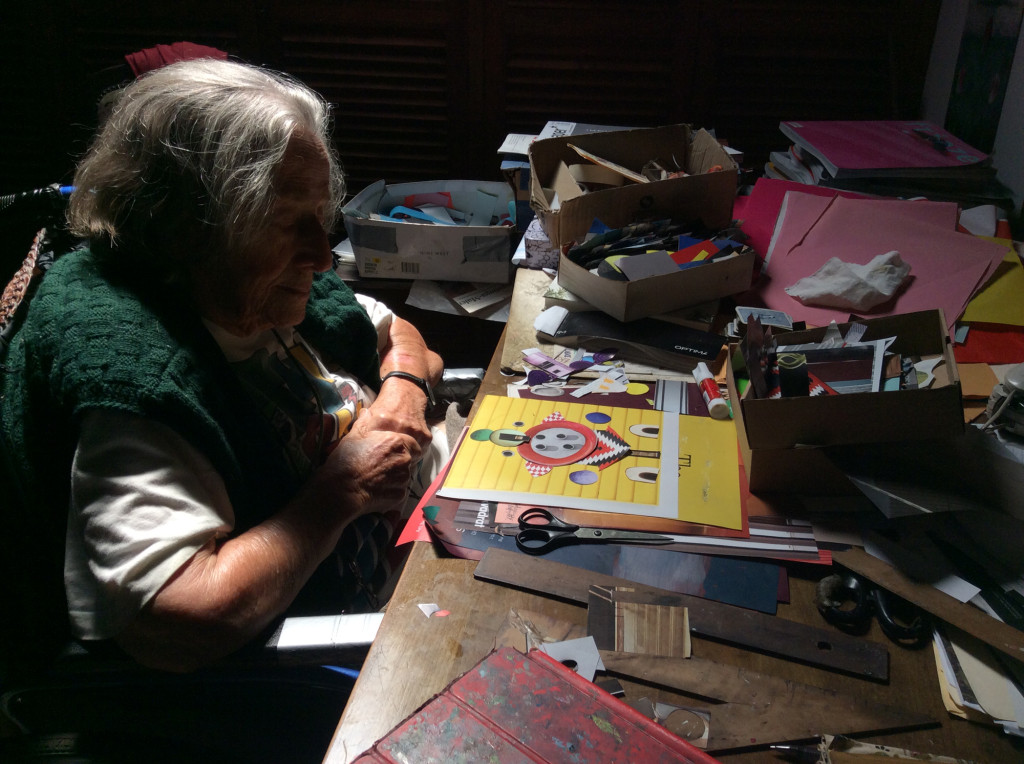[ad_1]
Elisabeth Wild, whose colorful collages disorient notions of perspective and architecture and were among the many surprises of Documenta 14 in 2017, has died at home in Guatemala. She had turned 98 earlier this month.
Wild is best known for her collages, which she began exhibiting internationally in 2014 as part of a midcareer survey for her daughter, artist Vivian Suter, at the Kunsthalle Basel in Switzerland. She participated in the show at Suter’s invitation. Wild had fully dedicated herself to art-making since 1996, when she moved from Switzerland to Panajachel, Guatemala, to be closer to Suter and Suter’s son, Panchito. (Suter had lived in Basel from 1962 until 1983, when she moved to Guatemala.)
The pieces by Wild that were included in the Kunsthalle Basel show were called “Fantasías” (Fantasies) and were created by culling the pages of various lifestyle magazines. The works are small and intimate—most measure no more than 10 inches on either side—but the worlds that Wild creates with them feel monumental and indeed fantastical: twisting staircases, soaring pillars, abstract forms that resembled kidney-shaped pools, and more.
During her lifetime, Wild had very few solo exhibitions. According to her CV, her first was in 2001 at Panajachel Gallery, where she showed a group of paintings, and her next was at her gallery in Guatemala City, Proyectos Ultravioleta, in 2014. At Ruberta, the collaborative exhibition space in Glendale, California, which is owned by five galleries in Latin America, Proyectos Ultravioletas gave Wild her first solo exhibition in the United States.
She would continue to exhibit her work primarily in the context of a two-person exhibitions with Suter, at the Mistake Room in Los Angeles in 2015, Proyectos Ultravioleta in 2016, Karma International in Los Angeles in 2017, and the Power Plant in Toronto in 2018. She also staged an exhibition with Naufus Ramírez Figueroa in 2017 at Greengrassi gallery in London as part of Condo.
But it was her inclusion in Documenta 14, under the direction of Adam Szymczyk, who had also organized the Kunsthalle Basel exhibition in 2014, that Wild’s work came to international prominence. (Suter also exhibited in that iteration of Documenta.) Szymczyk presented Wild’s work in both Athens and Kassel, Germany. Also part of the exhibition was a commissioned film by artist Rosalind Nashashibi, titled Vivian’s Garden (2017), a Grey Gardens–esque portrait that looked at the relationship between Suter and Wild.
Wild’s inclusion led to a solo exhibition at Carbon 12 gallery in Dubai earlier this year, and, according to a report in the Guardian, a career retrospective of Wild’s work is planned for 2021 at Vienna’s MUMOK.
“Elisabeth Wild was an artist who found her language and medium in collage at a relatively late stage in her career,” Szymczyk told ARTnews in an email. In Guatemala, “she developed her daily practice of collage, which enabled her to get a lot of work done with little physical effort, with patience and determination.”

Courtesy the artist and Proyectos Ultravioleta, Guatemala City
Elisabeth Wild was born on February 6, 1922, in Vienna to Franz and Stefanie Pollack, who were Jewish wine merchants. With her parents, they fled Nazi Europe in 1938 when she was 16 and settled in Buenos Aires. According to a 12-sentence narrative of her life that she recounted in 2012, which was republished on the Documenta 14 website, she learned painting at the Academy of Fine Arts Vienna, and she drew nudes under a master at the Círculo de Bellas Artes de Buenos Aires.
She participated in exhibitions in Buenos Aires as well as the coastal town of Mar del Plata, while also creating designs for textiles to earn a living. She would eventually marry a textile industrialist, August Wild, and in 1949, she gave birth to Suter, who would also become a prominent artist. In 1962, the family moved to Basel, Switzerland, where Elisabeth opened an antiques shop in a historic building.
Wild stayed in Basel until 1996 when she moved to Guatemala, where she reignited her art making, at first returning to painting and then moving into collage. Wild and Suter live in a somewhat remote part of the country on a former coffee plantation and have survived numerous hurricanes. In spite of all this, Wild continued making her art.
“Her work strikes you as totally accessible at first,” Szymczyk said, “but when you look at her collages closer, you get caught in the world that is hermetic. This world, however, is made of parts and pieces cut out from commercial imagery of glossy magazines that is perfectly from our world. She transformed images of commodity into witty, sometimes menacing images of a different reality.”
Szymczyk continued, “I sometimes wonder if there can be a visual equivalent to labyrinths and cul-de-sacs of one person’s mind and memory, and when I look at Elisabeth Wild’s collages, I imagine this equivalence very well. Through her work, I understood something of the way she understood and transformed the changing world that surrounded her during 98 years of her life on this planet.”
[ad_2]
Source link

